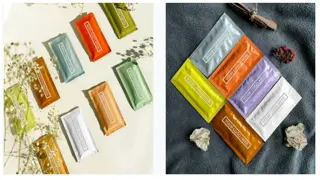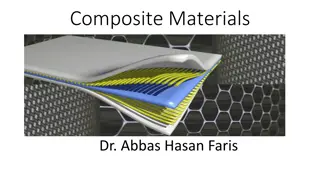Understanding the Hand Wet Lay-Up Process in Composite Fabrication
Hand wet lay-up involves combining reinforcing fibers like E-glass, S-glass, Aramid, or Carbon/Graphite with resins such as polyesters, vinyl esters, or epoxies during part fabrication. The process includes preparing molds/tools, applying mold release agents, starting with a gel coat, cutting fabric patterns, and weighing the resin components for desired fiber volume fraction.
Download Presentation

Please find below an Image/Link to download the presentation.
The content on the website is provided AS IS for your information and personal use only. It may not be sold, licensed, or shared on other websites without obtaining consent from the author. Download presentation by click this link. If you encounter any issues during the download, it is possible that the publisher has removed the file from their server.
E N D
Presentation Transcript
HAND (WET) LAY-UP COMBINING OF REINFORCING FIBER AND RESIN AT THE TIME OF PART FABRICATION
REINFORCING FIBER E-glass, S-glass, Aramid, Carbon/Graphite E-glass most common (process inherently produces lower "quality" composite laminate due to lack of tight resin content control and low compaction pressure) mat material randomly oriented chopped fibers or swirled continuous fibers which are held together loosely with a styrene-soluble binder 0.5 oz/sq ft - 3 oz/sq ft woven fabric material available on rolls in widths from 36 in. to 60 in. typically terminology and basic weave patterns (reference JPS Technical Reference Handbook and plied yarn construction figure) unidirectional fabric very fine filling (stitching) yarn biaxial fabric
RESINS polyesters vinyl esters epoxies
MOLD/TOOL PREPARATION procedure to some degree dependent on: tooling material whether tool is being used in first cycle or subsequent cycle clean tool scotch brite pad wipe with a clean cloth dampened with solvent (i.e., acetone) mold release agents waxes (carnuba-based) spray/liquid releases release films (sheet, PVA) internal releases (added to gel coat or resin system)
APPLYING A MOLD RELEASE AGENT preheat mold apply release agent allow period of time for release agent to "set up" (for wax) or "flash off" buff with clean cloth repeat application (particularly for first cycle) alternating pattern cure
THE WET LAY-UP PROCESS OFTEN BEGINS WITH A GEL COAT typically polyester, mineral filled (clays and carbonates), pigmented (different than mold color), non-reinforced layer or coating produces decorative, highly protective, glossy, colored surface little or no additional finishing required can paint on, roll on, or spray on allow gel coat to set (gel) barely tacky, but not release to the finger
CUTTING THE FABRIC cut desired pattern tools: shears, rotary cutters, and/or utility knife
WEIGHING OUT THE RESIN weigh out resin components in specified proportions to achieve desired resin content (desired fiber volume of finished part) epoxy curing agents/hardeners often expressed in parts per hundred by weight (phr) of epoxy resin or parts by weight see West System epoxy resin systems resin content expressed as percent by weight epoxy resins typically 25% - 35% by weight (part fiber volume?, dependent on ability to wet out fiber, amount of resin bleeding out during cure, etc.) need to account for process waste resin bleeding out, remaining on brushes, ... dependent on size of part (i.e. the smaller the part the greater the proportion of process waste) draw quantity of resin components, in separate containers thoroughly mix resin components (combine resin into curing agent container, move from container to container) tools: containers, stirrers
RESIN SYSTEM QUANTITIES FOR THE DEMONSTRATION PART 11 in x 11 in panel made of 16 plies of 120 E-glass cloth resin system is West System 105/206 epoxy resin system desired fiber volume in panel is 50% account for process waste
APPLY RESIN TO FABRIC apply resin to fabric on mold surface or, preferably, wet out fabric with resin on separate surface and transfer to mold resin may be sprayed, poured or brushed on, and spread with brush and/or squeegee applying resin on mold surface prior to laying of fabric facilitates removal of entrapped air during compaction process (resin is forced up through the fabric and the air is evacuated) applying resin to fabric on separate surface prevents resin rich areas (concave, negative, female contours) and resin starved areas (convex, positive, male contours) tools: paint brush, spray equipment, squeegee
COMPACTION resin should be applied, and the plies compacted on mold surface from the center to the outside to facilitate removal of entrapped air, visually able to see air moving pressure can be applied with a squeegee and/or serrated roller bridging on female contours (radii) must be avoided tools: squeegee, serrated rollers
VACUUM BAGGING SEQUENCE (VERTICAL BLEED)
PEEL PLY placed immediately on top of or under the composite laminate removed just before bonding or painting operations to provide clean, bondable surface woven fabric (nylon, polyester, or fiberglass) treated with nontransferable release agent
SEPARATOR (RELEASE FILM) nonperforated film is placed between laminate (or peel ply, if used) and tool (tool surface preparation often makes this film unnecessary) porous or perforated film is placed on top of laminate (and peel ply, if used, in some cases peel ply itself may serve as the porous film) porous or perforated film allows volatiles to escape from laminate and excess resin to bleed from laminate into bleeder plies during cure Spacing/size of perforations or porosity of material determines amount of resin flow from laminate surface
BLEEDER absorb excess resin from laminate during cure (resulting in desired fiber volume) fiberglass fabric or other absorbent materials or fabrics are used amount of bleeder used is a function of finished part fiber volume desired resin content absorbency of material
BARRIER between bleeder plies and breather nonperforated, nonadhering (release) film resins which produce excessive volatile by-products during cure (must be vented) by using film with small perforations and large spacing to prevent breather from becoming clogged with resin
BREATHER on top of barrier film to allow uniform application of vacuum pressure over laminate and removal of entrapped air or volatiles during cure drapable, loosely woven fabric, or felt
CAUL PLATES steel, aluminum, other sometimes used to maintain same heating and cooling rate as mold between barrier and breather more uniform application of pressure ensure a smooth, non-wavy surface
DAM located peripherally to minimize edge bleeding may be integral part of tool or rubber, metal bars, etc.
VACUUM BAGGING vacuum bag used to contain any vacuum pressure applied application of the vacuum bag extremely critical bag perforation must be prevented no sharp edges on tool properly sealed on edge no bridging (requires folds in bag) folds must be properly made, or undesirable wrinkles may occur in part bag sealant tape vacuum valves vacuum hoses vacuum source
CURING follow cure schedule recommended by resin supplier either room temperature or elevated temperature cure resin system
PREIMPREGNATED MATERIALS (PREPREGS) reinforcements impregnated with metered amounts of uniformly distributed resin processed to obtain optimum handling characteristics and reproducible cured laminate properties thermoset (and thermoplastic) resin systems (specify by % resin content by weight) reinforcing fiber (specify by type, form, areal weight) e-glass, s-glass, aramid, carbon/graphite unidirectional tape, woven fabric limited out time and shelf life
HAND LAY-UP OF PREPREGS mold preparation ply (prepreg) cutting (and kitting) allow prepreg to reach room temp (no condensation, min 2 hours) film adhesive may be used against mold surface release film is removed, ply is laid on mold using hand pressure, squeegee, and/or roller, then carrier sheet removed heat gun may be used to improve tack debulking (interim compactions) process materials and sequence is similar to wet lay-up cure autoclave (applies heat and pressure) cure cycle temperature and pressure ramp rates and holds out-of-autoclave prepregs need oven/vacuum pressure only






















